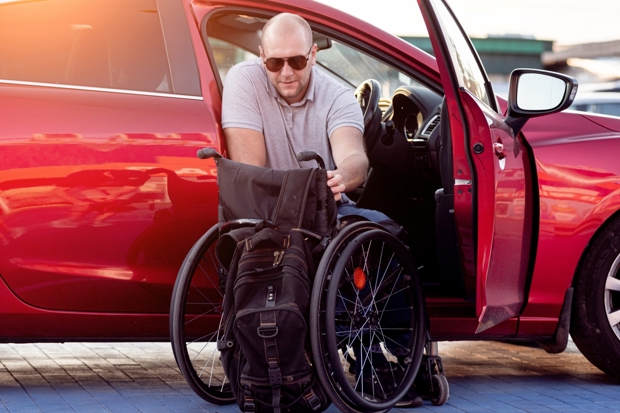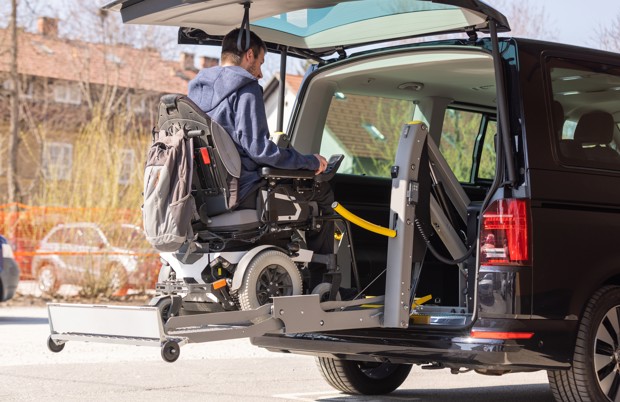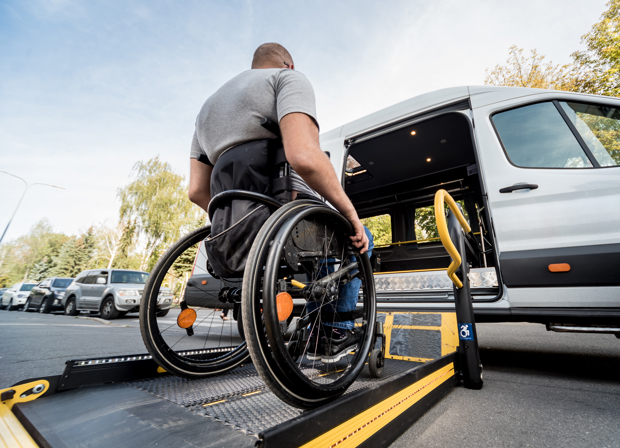Mobility cars: Your complete guide
Finding out whether you qualify for a mobility car before choosing the best model with adaptations tailored to your needs can be bewildering. Here's everything you really need to know.

- Could you qualify for a mobility car?
- Find out how to apply for one that suits you
- Adaptations and conversions explained
Mobility cars are vehicles that help disabled people to travel and live their lives more independently and easily.
For some, this may be a car without any adaptations while for others modifications or conversions may be required. These changes could be as straightforward as moving the pedal positions or replacing them with hand-operated controls as well as more radical re-engineering, such as making the car accessible from a wheelchair.
Wheelchair Accessible Vehicles (WAVs) feature additional equipment to make it easier for disabled drivers to get into and out of the driver’s seat or have access ramps and a revised cabin layout so a wheelchair user can travel safely in the vehicle while still in their chair.
How do I qualify for a mobility car?
People with disabilities or illnesses that reduce their ability to travel can apply for a benefit that pays for a vehicle lease with Motability. This is a charity that specifically provides cost-effective lease cars that can also be adapted where necessary to suit disabled drivers' needs.
In order to qualify for a mobility car through Motability you must have been awarded the higher rate of the mobility component of Disability Living Allowance (DLA), though this is being phased out for disabled people aged between 16 and 64 and being replaced by Personal Independence Payment (PIP).
If you have been awarded the higher or enhanced rate for the mobility component of PIP, with at least 12 months left to run, you are also eligible to use Motability.
War Pensioners’ Mobility Supplement and Armed Forces Independence Payment recipients also qualify, although a minimum of 12 months remaining on your current award is required.
You don’t have to be the driver of the car provided through Motability as it’s there to offer transport for the disabled person. This means parents and carers can drive Motability cars on behalf of anyone from the age of three-years-old but the vehicle has to be used for the disabled person's benefit. Drivers cannot use the car for their personal use if they are not the disabled person.
What is Personal Independence Payment (PIP)?
Personal Independence Payment (PIP) is a state benefit that helps with the additional costs of living with a long-term disability or illness. It is assessed by a health professional according to individuals' needs and is regularly reviewed to reflect any changes in the recipient’s condition.
The amount of PIP received depends on how someone's disability or illness affects their life more broadly rather than just concentrating upon the condition itself.
PIP is gradually replacing Disability Living Allowance (DLA) for anyone over the age of 16 or those born after 8 April 1948. Anyone currently receiving PIP will not be able to continue claiming it when they reach the State Pension Age
PIP can be applied for and granted regardless of whether or not a person already receives other benefits such as Employment Benefit or Support Allowance.
As it isn't means tested, any savings or income a person has do not affect their eligibility to claim PIP.
What is Motability?
While we refer to mobility as a term to encompass any vehicle that helps a disabled person travel, the name Motability has become almost interchangeable.
Motability is actually a registered charity that operates the Motability Scheme. This is not, as is often thought, funded by the government. Instead, the money comes from disabled people who choose to spend their higher rate mobility allowance to pay the cost of their lease.
It works with the Department for Work and Pensions (DWP) which facilitates the transfer of benefit to Motability.
Since it was set up in 1977, the Motability Scheme has provided over four million vehicles and provides cars, wheelchair accessible vehicles (WAVs), scooters and powered wheelchairs. Currently more than 600,000 disabled people and their families across the UK have a vehicle through the scheme.
How much does a mobility car cost?
Cars leased through Motability use some or all of the claimant's mobility allowance to fund the lease payment. There are hundreds of different cars available through the scheme, so people can choose which one which suits them best, with their allowance being paid directly from the government to Motability.
If the weekly lease price is less than the total allowance, the difference will be paid to the claimant by the Department for Work and Pensions (DWP) or Veterans UK. This can all be arranged via a Motability-approved dealer or directly with Motability itself.
Even if the weekly lease cost rises during the lease period, existing lease agreements remain unaltered.
Also included with Motability's lease costs are all servicing and MoT costs, breakdown cover and insurance for up to three named drivers, all of whom must live at the same address.
Where the the cost of a car exceeds the claimant's weekly allowance, Motability will take a one-off advance payment to cover the difference. After that, all of the mobility allowance will be paid directly to Motability.
All Wheelchair Accessible Vehicles (WAVs) require an advance payment due to the high cost of the re-engineering work, although choosing a used WAV can reduce this significantly. WAV lease deals through Motability run for five years.
Just as with arranging a finance any car, factory fitted optional extras will increase the Motability weekly lease cost but many adaptations tailored for a disabled driver's needs, such as minor pedal alterations and indicator and wiper stalk extensions, do not incur additional fees.
Note that any necessary adaptations that might only become apparent post-delivery have to be paid for separately.
Which types of cars are available through Motability?
There is a wide variety available through Motability although most focus is given to cars that are straightforward to drive and are inherently easier to access.
As a result, the vast majority of cars available to lease via Motability have automatic transmissions with taller styles of bodywork, as is typically found with SUVs and van-based people carriers. Not only do they allow for easier entry and exit, they tend to have more space available for stowing wheelchairs.
However, not everyone leasing a Motability car requires such a degree of space or may simply prefer driving a manual, hence why over 2000 different make and model combinations are available.

Does Motability lease electric cars?
Yes, fully electric cars can be leased through Motability and can make for a great choice given how easy they are to drive. Also, with fewer mechanical components, making tailored adaptations to suit different drivers' needs is also more straightforward.
Motability's package also includes either a home wallbox for clients with their own driveway or garage or a BP Pulse account for those where that's not a possibility. Whichever option the customer chooses, additionally they will receive a Motability Go charge card giving access to over 45,000 other public charge points, but not at any discounted prices.
While using faster public charging facilities is an option, especially on longer excursions, the unfortunate truth is access to these, particularly passing between cars when moving between the charger and plugging the car in, is often unacceptably poor, especially for wheelchair users.
More forethought from the companies involved in the installation is required as is a tightening-up of specific accessibility legislation.
Is Motability the only source of mobility cars?
For those who don't wish to use Motability, there are several other companies that lease mobility cars or hire them for short periods.
Leasing or hiring a mobillity car is no different from any other. Decide which terms are most appropriate in terms of agreement length and mileage caps before paying the one-off initial rental fee — note this isn't a deposit you get back at the end — and that's it. All very straightforward.
The key differences are that the lease deals aren't always as favourably priced as Motability's ones but there is potentially a mucher wider range of makes and models available to choose from.
Which are the best WAVs?
There are two main options when choosing a Wheelchair Accessible Vehicle (WAV). The first is to lease through Motability, which has a choice of new or nearly new models with all of the conversion work already completed. This is a no-hassle way to get hold of a WAV, with the flexibility to tailor it to specific needs.
The other option is to have an existing vehicle converted, assuming it’s suitable for the intended purpose.
Converting a car to a WAV is a specialist task to make sure the vehicle meets the required safety standards. The vehicle will need to meet Low Volume Type Approval (LVTA) or pass an Individual Vehicle Approval (IVA) test which adds to the cost of the conversion.
Prices for conversion work vary depending on the type of adaptations needed and you will need to choose whether you want side or rear access and whether it’s a drive-from-wheelchair conversion.
An much less expensive alternative is to opt for a powered lift system to raise the wheelchair user and chair into the car. This is a more compact option and gives a wider choice of cars to pick from.
The most well-known WAV convertors are:
What to look for when buying a used mobility car
By far the most important factor when considering a used mobility car is that it suits your needs or the person who will be driven about in it. Many mobility cars will have adaptations fitted that were specific to the original driver, such as hand controls, an easy-release parking brake or extended seat runners to make entry and exit easier. Some of the adaptations may suit you, others could be a hindrance.
Used cars that have previously been leased through Motability are usually very well cared for as the lease deal includes all servicing, maintenance and tyre replacement. However, the usual used car checks still apply, so check the car's condition and service record tally witch each other.
Ensure you take a test drive to be confident that the car fits the requirements of your disability or the disabled person it's for.
If you're buying a nearly new WAV then be aware that not all models will be available through Motability. Those that are, will come with a three-year, 60,000-mile lease deal rather than the five-year, 100,000-mile deal for new ones. However, most nearly new WAVs require a much smaller advance payment or none at all.
Can I hire a mobility car?
There are several companies that provide mobility vehicle hire, offering everything from small hatchbacks all the way to large minibuses with wheelchair access.
Hiring a mobility vehicle is a cost-effective option if you only need it for a short period, such as being on holiday. Most companies offer daily, weekly and monthly rates for vehicles with hand controls or wheelchair access. There are also longer lease deals for up to 12 months available from many companies.
Recognising that many disabled people may find it harder to come to a vehicle hire centre, most mobility hire companies offer a drop-off and collection service. As with any hire or lease agreement, make sure you know what is included and excluded from the deal before signing up.

Can I learn to drive in a mobility car?
Yes, of course. When you pass your test your driving licence will state which categories of vehicle you’re permitted to drive.
Unusually, if you receive the higher rate of mobility allowance, you can learn to drive from the age of 16 providing you have a provisional licence, are insured and are accompanied by a driver over the age of 21 with at least three years' full licence driving experience and who is also named on your insurance policy.
You can apply for a provisional licence up to three months ahead of your 16th birthday. However, any other learner drivers using a mobility car must be over 21-years old, live at the same address and you can only have one learner driver on the vehicle’s insurance at any given time.
There is financial help available to learner drivers through Motability if they are a current customer, which means a parent or carer has been driving the car previously. This assistance can provide up to 40 hours of driving tuition, though you must complete these driving lessons within a 12-month period.
With Motability, young drivers under the age of 25 are restricted to cars with an ABI Insurance Group no higher than 16 and maximum power not exceeding 120PS. However, for those learning to drive in a WAV, there are no such restrictions. Some driving schools offer mobility cars and WAVs for learner drivers.
Can mobility cars be driven for personal use?
This depends entirely who is asking.
If the disabled person leasing the car through Motability is the one driving it, then unequivocally yes they can — they're perfectly entitled to drive it as much or as little as they wish to.
For any other named driver in the same household, the car can be driven providing the journey in some way relates to the disabled person benefiting from it, even if they aren't in the vehicle. This could include using the car for grocery shopping or picking up other family members or friends to bring them to the home address for a visit.
A named driver using the Motability car purely for their own benefit is not permitted.
Can an existing car be traded-in for a mobility vehicle?
Yes, it can. Motability allows for already owned cars to be part-exchanged for one of its newly leased vehicles. Depending on its value, this could also be used to cover part or the whole of any required advanced payment.
Do your homework in advance, though, as not all Motability-approved dealers off this function, in which case you would have to sell the old car by some other means.
What happens at the end of a Motability lease?
At the end of the lease deal with Motability, you can choose to remain on the scheme and order a new car. This would be delivered the same day as you hand back your old car, so there’s no interruption or inconvenience to you.
Alternatively, you can also choose to leave the scheme with nothing else to pay.
If your circumstances change during your Motability lease period, such as your mobility award is being renewed, you can hand back the car with no additional costs. You could also be eligible for a £250 Return to Dealer payment.
